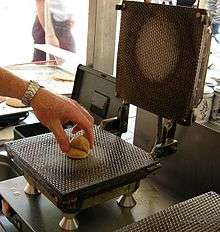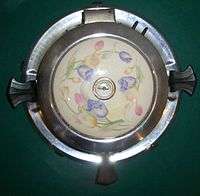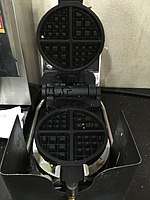Waffle iron
A waffle iron or waffle maker is a utensil or appliance used to cook waffles. It comprises two metal plates with a connecting hinge, molded to create the honeycomb pattern found on waffles. The iron is heated and either batter is poured or dough is placed between the plates, which are then closed together to bake breakfast delicacies with a sweet dessert flavor, very similar to pancakes but lighter and sweeter. The appearance is much harder to achieve than a pancake; hence the waffle iron.[1]



Varieties
Traditional waffle irons are attached to tongs with wooden handles and held over an open flame, or set on a stove. Most modern ones are self-contained tabletop electrical appliances, heated by an electric heating element controlled by an internal thermostat. Electric irons come with either removable or non-removable plates.[2] Professional waffle makers are usually made of uncoated cast iron whereas domestic models, particularly cast aluminum ones, are often teflon coated. Many have a light that goes off when the iron is reaches the set temperature.
Modern versions offer multiple choices. Some make a very thin waffle, capable of making waffle cones or Pizzelle. While there is no set standard for waffle shapes or thicknesses, models that produce the most common shapes and thicknesses are often labeled as "traditional" or "classic". Models that make thicker and/or larger pocketed waffles are often labeled as "Belgian". In the US, the most commonly used determinant of whether a waffle is a "Belgian waffle" or not is thickness and/or pocket size, although the recipes for Belgian waffles and American waffles do differ.
History
The earliest waffle irons originated in the Low Countries around the 14th century.[3] These were constructed of two hinged iron plates connected to two long, wooden handles. The plates were often made to imprint elaborate patterns on the waffle, including coat of arms, landscapes, or religious symbols. Waffles would be baked over the hearth fire.
In 1869, American Cornelius Swartwout patented the stove-top waffle iron. While waffle irons of sorts may have existed since the 1400s, Swarthout intended to perfect the design by adding a handle and a hinge that swivelled in a cast-iron collar,[4][5][6] allowing the waffle-maker to flip the iron without danger of slippage or burns.[7]
In 1891 John Kliembach, a German immigrant living in Shamokin, Pennsylvania, became a traveling salesman of waffles after fashioning an iron for the Mansion House Hotel. Kliembach sold waffles for a penny each or ten cents for a dozen.[8] This was popular at the Chicago World's Fair.
It was not until 1911 that General Electric produced a prototype electric waffle iron, and production began around 1918.[8] Later, as the waffle iron became more prevalent, its appearance was improved.
Other uses
In 1971, Oregon track coach and Nike Co-founder Bill Bowerman used his wife's waffle iron to experiment on rubber to create a new sole for track shoes that would grip but be lightweight and increase the runner's speed. Oregon's Hayward Field was transitioning to an artificial surface and "Bill wanted a sole without spikes that could grip equally well on grass or bark dust." He was talking to his wife about this puzzle over breakfast, when the waffle iron idea came into play.[9] Bowerman's design led to the introduction of the "Moon Shoe" in 1972, so named because the waffle tread was said to resemble the footprints left by astronauts on the moon. Further refinement resulted in the "Waffle Trainer" in 1974, which helped fuel the explosive growth of Blue Ribbon Sports/Nike.[10][11]
Gallery
 1940s ElectraHot (Minneapolis, MN) waffle iron with a Hall China insert
1940s ElectraHot (Minneapolis, MN) waffle iron with a Hall China insert- Waffle iron with logo of Country Inns & Suites, advertising the company logo on waffles made by customers
 This is a waffle iron of the type commonly found at breakfast counters at motels/hotels in America. Customers pour in batter, close the waffle iron, and a timer begins, then sounds off when the waffle is ready.
This is a waffle iron of the type commonly found at breakfast counters at motels/hotels in America. Customers pour in batter, close the waffle iron, and a timer begins, then sounds off when the waffle is ready.- A waffle iron in the shape of Texas, commonly found at motels in Texas
See also
| Wikimedia Commons has media related to Waffle irons. |
- Brown Bobby, a triangular American donut made in a waffle iron like machine
- Krampouz, a French manufacturer of small cooking appliances
- List of cooking appliances
- Pancake machine
- Sandwich toaster, various machines, often waffle iron sized, that press and cook a filling between two slices of bread, to make a hot filled sandwich, with the edges sealed together
- Waffle
References
- Mifflin, Mariette. "Waffle Maker - Definition and Use". The Spruce. The Spruce. Retrieved 26 April 2018.
- "Step-by-Step Guide on How to Clean a Waffle Maker". EnderWaffle. 2018-04-20. Retrieved 2018-04-20.
- Helene Siegel (1 September 1996). Totally pancakes and waffles cookbook. Random House Digital, Inc. ISBN 978-0-89087-804-0. Retrieved 1 November 2011.
- Marquis Who's Who Staff; Marquis Who's Who (1967). Who was who in America: a companion biographical reference work to Who's who in America. Marquis-Who's Who. p. 58. Retrieved 1 November 2011.
- "Cornelius Swartwout: Inventor of the Waffle Iron". The Swarthout Family. Mark Swarthout. Retrieved 2016-02-16.
- Cornelius Swartwout U.S. Patent 94,043 Waffle iron issued on August 24, 1869
- Rushing, Erin. "Waffle Iron Patented". Unbound. Smithsonian Library. Retrieved 26 April 2018.
- George, William (2003). Antique Electric Waffle Irons 1900-1960: A History of the Appliance Industry in 20th Century America. Trafford Publishing. p. 13. (For the GE 1911 model description, p. 74, click here)
- Peterson, Hayley. "The bizarre inspiration behind Nike's first pair of running shoes". Business Insider. Business Insider. Retrieved 26 April 2018.
- Douglas Holt; Douglas Cameron (1 November 2010). Cultural Strategy: Using Innovative Ideologies to Build Breakthrough Brands. Oxford University Press. pp. 41–. ISBN 978-0-19-958740-7. Retrieved 1 November 2011.
- Jeroen Scheerder (2010). Vlaanderen loopt! Sociaal-wetenschappelijk onderzoek naar de loopsportmarkt. Academia Press. pp. 75–. ISBN 978-90-382-1484-9. Retrieved 1 November 2011.